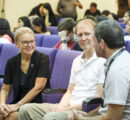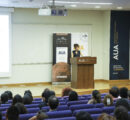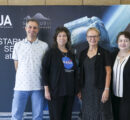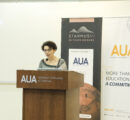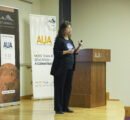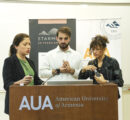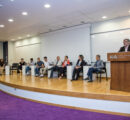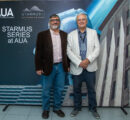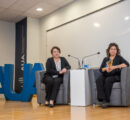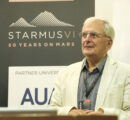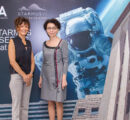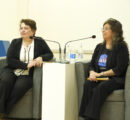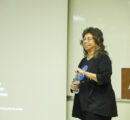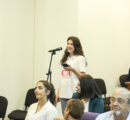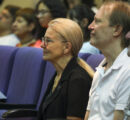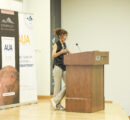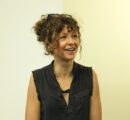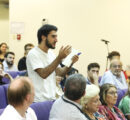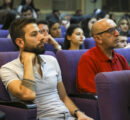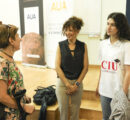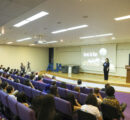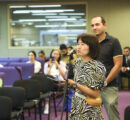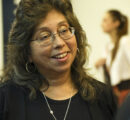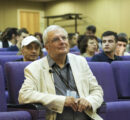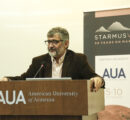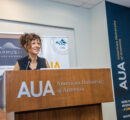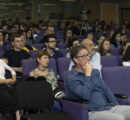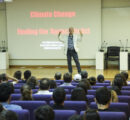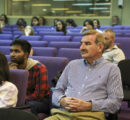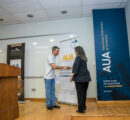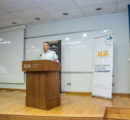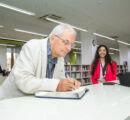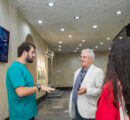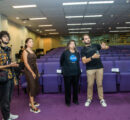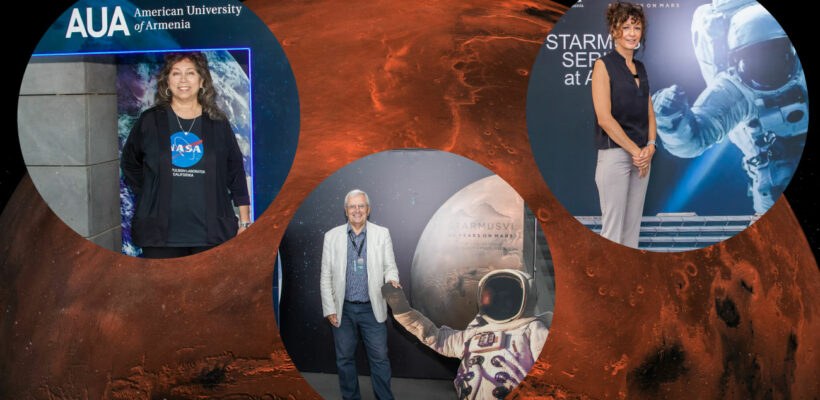
AUA Hosts Starmus Speaker Series
4 min readYEREVAN, Armenia — From September 5-10, the Starmus VI Festival took Yerevan by storm. Starmus is a global festival of science communication and art that brings together the most brilliant minds on the planet. As part of the festivities, the American University of Armenia (AUA), an official university partner, hosted the Starmus Speaker series with three speakers presenting their rich experiences in science and art to the AUA community and general public.
Taking the stage in this segment of Starmus were Nagin Cox, a systems engineer at NASA’s Jet Propulsion Laboratory in California, University College London Professor Christopher Rapley, and Emmanuelle Charpentier, a French researcher in microbiology, genetics, and biochemistry. Covering topics about space, the environment, and science, respectively, the three speakers encouraged students to create their own path, live their purpose, and choose academia. They emphasized the small but critical roles each of us can play in making new discoveries and influence international phenomena, thereby shaping not only their own academic and professional paths, but also the course of human history and achievement. In order to accomplish this, the speakers highlighted the importance of keeping abreast of the challenges facing humanity, as this awareness motivates discovery and innovation.
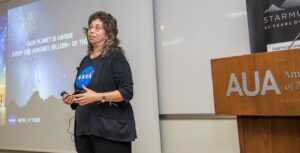 First in the Starmus Speaker Series was Cox on September 6. Following introductory remarks by the AUA Akian College of Science and Engineering (CSE) Dean Dr. Aram Hajian, she began by explaining how the late Apollo missions had inspired her in their ability to bring people together across national boundaries and sparked her interest in space. She reviewed the history of NASA programs from the Space Race era of the 1960s — when its budget was the highest — to the present day. Cox recounted her work on the four Mars rovers, Spirit, Opportunity, Curiosity, and Perseverance, the latter having landed in February 2021.
First in the Starmus Speaker Series was Cox on September 6. Following introductory remarks by the AUA Akian College of Science and Engineering (CSE) Dean Dr. Aram Hajian, she began by explaining how the late Apollo missions had inspired her in their ability to bring people together across national boundaries and sparked her interest in space. She reviewed the history of NASA programs from the Space Race era of the 1960s — when its budget was the highest — to the present day. Cox recounted her work on the four Mars rovers, Spirit, Opportunity, Curiosity, and Perseverance, the latter having landed in February 2021.
With words of encouragement in her dialogue with the audience, Cox emphasized that each of us can play a significant role in the progression of major events and phenomena. “Challenges — whether environmental, scientific, or medical — take time to resolve. That is important, because, sometimes it isn’t going to be during our career where something major happens, but you can be part of a movement that takes time to achieve its objective,” she said.
Concluding her speech with a famous photo depicting the earth from the moon’s orbit, Cox remarked, “There is nothing about talent that stops at borders. We need all the talent in the world to seek out science and truth and to understand that there is a path forward for our species, but it involves all of us working together…You get to choose what you do with your 100 years.”
Dr. Naira Hovakimyan, a Fulbright scholar at AUA, then led the audience through a Fireside Chat and Q&A session with Cox. The NASA engineer discussed how NASA establishes a comprehensive understanding of Mars through the information received from rovers and other technologies, as well as how research findings are validated, among other related subjects.
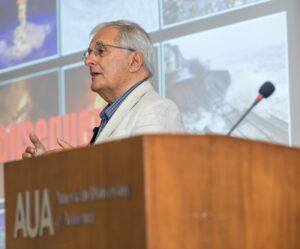 Next, on September 7, University College London Professor Christopher Rapley delivered a talk titled “Climate Change Finding the ‘Agency’ to Act.” After an introduction by Director of the AUA Acopian Center for the Environment Alen Amirkhanian, Rapley began by introducing the audience to hunger stones, hidden archeological relics that have recently emerged due to receding water levels linked to climate change.
Next, on September 7, University College London Professor Christopher Rapley delivered a talk titled “Climate Change Finding the ‘Agency’ to Act.” After an introduction by Director of the AUA Acopian Center for the Environment Alen Amirkhanian, Rapley began by introducing the audience to hunger stones, hidden archeological relics that have recently emerged due to receding water levels linked to climate change.
He then segued into a detailed explanation of climate science and the effects of climate change on the earth and its atmosphere. He detailed the real-world consequences of climate change, delineating the causation from rising sea levels to infrastructure damage, to economic and political instability. Despite these daunting ramifications, Rapley encouraged the audience not to succumb to feelings of anxiety and hopelessness. Instead, through a detailed explanation of the brain’s operational mechanisms, he explained how to channel and transform these feelings into positive action.
He left the audience with words of motivation: “The future is not written, and you are important scriptwriters. You write the future. Do it now. But don’t write it in red; write it in green, which is the color of hope.”
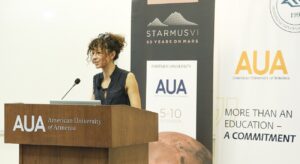 Rounding out the Starmus Speaker Series was Charpentier taking the stage on September 8. Introduced by Dean of the AUA Turpanjian College of Health Sciences Dr. Varduhi Petrosyan, Charpentier proceeded to delineate her research journey towards developing the CRISPR/Cas9 genome engineering technology. She opened with sincere acknowledgments to all who facilitated this research, echoing Cox’s recognition of the importance of teamwork and the meaningful contribution every individual can make towards a movement.
Rounding out the Starmus Speaker Series was Charpentier taking the stage on September 8. Introduced by Dean of the AUA Turpanjian College of Health Sciences Dr. Varduhi Petrosyan, Charpentier proceeded to delineate her research journey towards developing the CRISPR/Cas9 genome engineering technology. She opened with sincere acknowledgments to all who facilitated this research, echoing Cox’s recognition of the importance of teamwork and the meaningful contribution every individual can make towards a movement.
“In science nowadays, it’s very difficult — specifically in the field of life sciences — to survive without an environment that is multidisciplinary,” she said. “Right now, my unit can be self-sufficient to a certain extent, because I have set it up with different scientists bringing different types of expertise… Collaborations are often necessary if one wants to go beyond and foresee what could be the potential of a research project.”
Next, Charpentier explained the scientific mechanisms behind the CRISPR technology, starting from recounting the history of DNA and RNA research to detailing how the technology could be applied to modern medical treatments, highlighting the importance of maintaining a focus on the fundamental sciences. She cited the SARS-COV-2 RNA vaccines as examples of how modern treatments build on deep, long-established research. Her closing words were those of encouragement to undergrad students to carry on studying and researching science in order to pass on new knowledge to future generations. “As much as the private sector may be very attractive, it’s important to uphold this responsibility of maintaining sustainability for future generations in the educational system and pure fundamental research system,” she concluded.
Through their interactive and dynamic speeches, Cox, Rapley, and Charpentier each illustrated how teamwork achieved via a comprehensive transdisciplinary approach and commitment to living a life of purpose can allow each of us to play a critical role in addressing the complex issues facing our world today.
Founded in 1991, the American University of Armenia (AUA) is a private, independent university located in Yerevan, Armenia, affiliated with the University of California, and accredited by the WASC Senior College and University Commission in the United States. AUA provides local and international students with Western-style education through top-quality undergraduate, graduate, and certificate programs, promotes research and innovation, encourages civic engagement and community service, and fosters democratic values.

